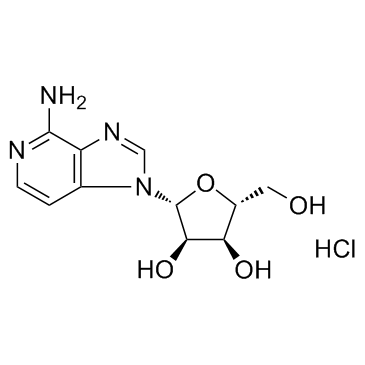3-Deazaadenosine hydrochloride
Modify Date: 2025-09-06 17:05:08

3-Deazaadenosine hydrochloride structure
|
Common Name | 3-Deazaadenosine hydrochloride | ||
|---|---|---|---|---|
| CAS Number | 86583-19-9 | Molecular Weight | 302.71 | |
| Density | N/A | Boiling Point | N/A | |
| Molecular Formula | C11H15ClN4O4 | Melting Point | N/A | |
| MSDS | N/A | Flash Point | N/A | |
Use of 3-Deazaadenosine hydrochloride3-Deazaadenosine (hydrochloride) is an inhibitor of S-adenosylhomocysteine hydrolase, with a Ki of 3.9 µM; 3-Deazaadenosine has anti-inflammatory, anti-proliferative and anti-HIV activity. |
| Name | 3-Deazaadenosine hydrochloride |
|---|
| Description | 3-Deazaadenosine (hydrochloride) is an inhibitor of S-adenosylhomocysteine hydrolase, with a Ki of 3.9 µM; 3-Deazaadenosine has anti-inflammatory, anti-proliferative and anti-HIV activity. |
|---|---|
| Related Catalog | |
| Target |
IC50: 0.15 (HIV-1, A012 isolate), 0.20 µM (HIV-1, A018 isolate)[1] Ki: 3.9 µM (S-adenosylhomocysteine hydrolase)[1] |
| In Vitro | 3-Deazaadenosine is an inhibitor of S-adenosylhomocysteine hydrolase, with a Ki of 3.9 µM. 3-Deazaadenosine shows anti-HIV effect, and inhibits p24 antigen in peripheral blood mononuclear (PBMCs) cells infected with HIV-1 isolates (A012 and A018) with IC50s of 0.15 and 0.20 µM, respectively[1]. 3-Deazaadenosine (1-100 µM) inhibits LPS-induced expression of TNF-α mRNA, increases DNA binding activity of NF-κB, and causes proteolytic degradation of IκBα, but Not IκBβ in RAW 264.7 cells. 3-Deazaadenosine (100 µM) enhances nuclear translocation of NF-κB, but blocks LPS-induced NF-κB transcriptional activity, and such inhibition is augmented by the addition of homocysteine[2]. 3-Deazaadenosine (50, 100 µM) dose-dependently inhibits the phosphorylation of Raf and ERK, protein-dependent kinase 1, protein kinase B (Akt), and forkhead transcription factor FoxO1a. 3-Deazaadenosine (50 µM) suppresses vascular smooth muscle cell (VSMC) proliferation via interfering with Ras signaling[3]. |
| Cell Assay | The HIV-1 strains A012 and A018 are used in the assay. Inhibition of p24 antigen is measured. Briefly, PHA-stimulated peripheral blood mononuclear (PBMCs) are incubated with either HIV-1 strain for 1 h at 37°C at 200-fold the 50% tissue culture infectious dose (TCID50) of the virus stock per 2 × 105 PBMC cells. The TCID50 is defined as the amount of virus stock at which 50% of the inoculated wells are positive. Cells are then grown in microtiter plates with different drug concentrations at 2 × 105 cells per well. On day 4, cells are resuspended and split 1:3 with fresh media and 3-Deazaadenosine. Supernatant p24 antigen is determined on day 7 by ELISA[1]. |
| References |
| Molecular Formula | C11H15ClN4O4 |
|---|---|
| Molecular Weight | 302.71 |
| Storage condition | 2-8℃ |